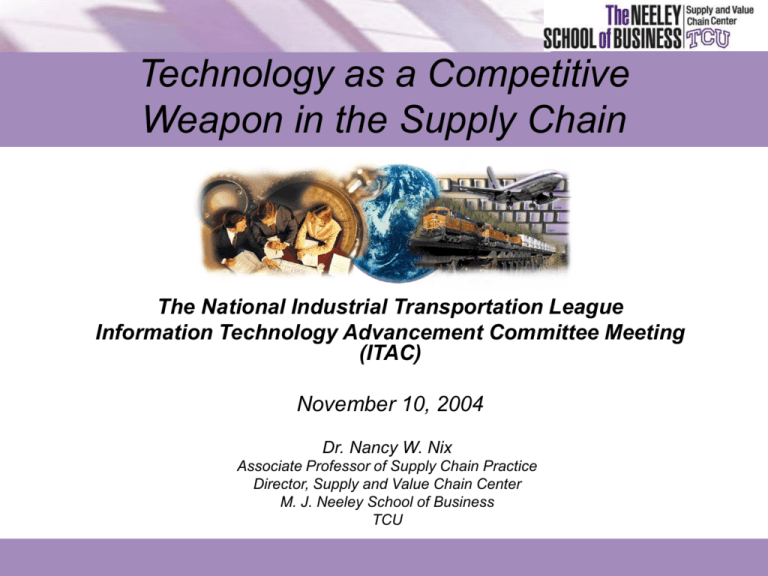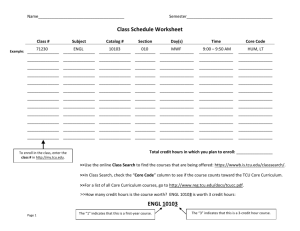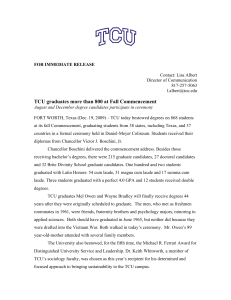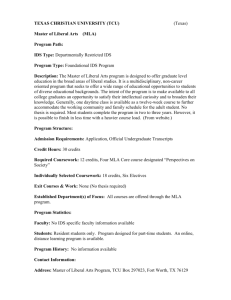
Technology as a Competitive
Weapon in the Supply Chain
The National Industrial Transportation League
Information Technology Advancement Committee Meeting
(ITAC)
November 10, 2004
Dr. Nancy W. Nix
Associate Professor of Supply Chain Practice
Director, Supply and Value Chain Center
M. J. Neeley School of Business
TCU
Agenda
• Setting the Stage -Technology as a Competitive
Weapon?
• Supply Chain Management – The Big Picture
• Defining the Opportunity for Competitive Advantage
• Keys to Supply Chain Success
• Summary and Wrap-up
© TCU Supply and Value Chain Center - 2004, All Rights Reserved, 11.10.04 Technology as a Competitive Weapon in the Supply Chain
Page 2
© TCU Supply and Value Chain Center - 2004, All Rights Reserved, 11.10.04 Technology as a Competitive Weapon in the Supply Chain
Page 3
“IT Doesn’t Matter”
As availability of IT has increased and its cost
has decreased, information technology has
become a commodity.
“IT Doesn’t Matter” by Nicholas G. Carr, HBR At Large, May 2003
© TCU Supply and Value Chain Center - 2004, All Rights Reserved, 11.10.04 Technology as a Competitive Weapon in the Supply Chain
Page 4
“Does IT Matter?”
Cost of Processing Power Per MIPS
$500
Cost
$400
$300
$200
$100
$1975
1980
1985
1990
1995
2000
Year
“IT Doesn’t Matter” by Nicholas G. Carr, HBR At Large, May 2003
© TCU Supply and Value Chain Center - 2004, All Rights Reserved, 11.10.04 Technology as a Competitive Weapon in the Supply Chain
Page 5
“Does IT Matter?”
• What makes a resource truly strategic – what
gives it the capacity to be the basis for
sustained competitive advantage – is not …
its availability …. but its scarcity.
• Has the strategic importance of technology
as a competitive weapon diminished?
“IT Doesn’t Matter” by Nicholas G. Carr, HBR At Large, May 2003
© TCU Supply and Value Chain Center - 2004, All Rights Reserved, 11.10.04 Technology as a Competitive Weapon in the Supply Chain
Page 6
Growth in IT Investment
IT Spend as a % of Capital Expenditures
60%
50%
40%
30%
20%
10%
0%
1960
1970
1980
1990
2000
2010
“IT Doesn’t Matter” by Nicholas G. Carr, HBR At Large, May 2003
© TCU Supply and Value Chain Center - 2004, All Rights Reserved, 11.10.04 Technology as a Competitive Weapon in the Supply Chain
Page 7
Impact of IT Investment on Productivity
• 2001 McKinsey study found a significant positive
correlation between IT investment and improved
productivity in only six out of 59 industries
• In each of those six sectors, one or more companies
introduced significant innovations in business
practices to leverage IT capabilities
“Does IT Matter? by John Seeley Brown and John Hagel III, Harvard Business Review, July 2003
© TCU Supply and Value Chain Center - 2004, All Rights Reserved, 11.10.04 Technology as a Competitive Weapon in the Supply Chain
Page 8
Supply Chain Technology Performance
The McKinsey Quarterly, Number 1, 2003
© TCU Supply and Value Chain Center - 2004, All Rights Reserved, 11.10.04 Technology as a Competitive Weapon in the Supply Chain
Page 9
Factors Influencing IT “Failures”
• Focus on automating existing processes
• Patching with obsolescent technology
• Not learning from experience
• Unrealistic expectations
• Misalignment of technology and business strategy
• Lack of accountability for results
© TCU Supply and Value Chain Center - 2004, All Rights Reserved, 11.10.04 Technology as a Competitive Weapon in the Supply Chain
Page 10
Impact of IT Investment on Productivity
• 2001 McKinsey study found a significant positive
correlation between IT investment and improved
productivity in only six out of 59 industries
• In each of those six sectors, one or more companies
introduced significant innovations in business
practices to leverage IT capabilities
“Does IT Matter? by John Seeley Brown and John Hagel III, Harvard Business Review, July 2003
© TCU Supply and Value Chain Center - 2004, All Rights Reserved, 11.10.04 Technology as a Competitive Weapon in the Supply Chain
Page 11
The Opportunity for Creating Competitive
Advantage?
• While IT may be readily available and increasingly less
expensive, the insight and ability required for it to
create economic value are in very short supply.”
“It’s the combination of IT and innovation
that helps companies outpace rivals.”
“Does IT Matter? by John Seeley Brown and John Hagel III, Harvard Business Review, July 2003
© TCU Supply and Value Chain Center - 2004, All Rights Reserved, 11.10.04 Technology as a Competitive Weapon in the Supply Chain
Page 12
Effective IT Planning and Implementation
•
•
•
•
•
•
•
Top management involvement and support
Alignment of business strategy and technology strategy
Use technology to enable innovation and business processes
Cross-functional teams
Well-developed implementation plan
Clear guidelines on performance measurement
Clear guidelines on how to work with consultants and transfer
knowledge
• Well-developed plans for training employees
“Enterprise Resource Planning Systems: Common Myths versus Evolving Realities,” Mabert, Soni, and
Venkataramanan, Business Horizons, May 2001.
© TCU Supply and Value Chain Center - 2004, All Rights Reserved, 11.10.04 Technology as a Competitive Weapon in the Supply Chain
Page 13
Supply Chain Management
The Big Picture
© TCU Supply and Value Chain Center - 2004, All Rights Reserved, 11.10.04 Technology as a Competitive Weapon in the Supply Chain
Page 14
Fundamental Objectives of Supply
Chain Management
Integrating Supply and Demand Management
Match Supply
Management
With Demand
Management
To Maximize Profits and
Support Corporate Objectives
© TCU Supply and Value Chain Center - 2004, All Rights Reserved, 11.10.04 Technology as a Competitive Weapon in the Supply Chain
Page 15
The speed of
travel across
time
1992: World Wide Web
Atomic boats,
high speed railway,
auto & rocket jets
Steamships,
railways, auto,
jet & rocket aircraft
Steamships,
transcont. Railroad,
autos & airplanes
Steam boats &
railroad
Big sail boats
w. Compass
Larger boats,
horse carriots,
pack animals
Canoe w. Sail
and paddle
Foot & canoe
Man on foot
1969: Internet
1965: Transcontinental Television
(Early Bird Satelite)
1950: National Television
1920: First commercial radio broadcast
1895: Marconi telegraph
1876: Bell telephone
1863: rapid print newspaper press
Prior to 1441 a.d.:
- word of mouth
- drums
- smoke
- relay runners
10000
5000
1441: Gutenberg printing press
1000
BC
500
1000
1500 1600 1700 1800 1900
‘50 ‘70 ‘90
AC
Source: Buckminster Fuller
© TCU Supply and Value Chain Center - 2004, All Rights Reserved, 11.10.04 Technology as a Competitive Weapon in the Supply Chain
Page 16
Drivers for Supply Chain Management Why Important, Why Now?
Speed of Change
High Levels of
Uncertainty
Intense Competition
Supply Chain
Collaboration
Accelerates
Innovation and
Adaptation
Outsourcing
Technology
Complex, Interdependent
Networks
© TCU Supply and Value Chain Center - 2004, All Rights Reserved, 11.10.04 Technology as a Competitive Weapon in the Supply Chain
Page 17
Defining Supply Chain Management
Supply Management
Focal Firm
Demand Management
NPD
Procurement
Production
Distribution
Customer
Service
Performance Measurement
Customers
Integrated Forecasting and Planning
Customers
Suppliers
Suppliers
Supply Chain Strategy and Supporting Processes
Information Systems
Product, Service, Information and Financial Flows
NPD = New Product Development
© TCU Supply and Value Chain Center - 2004, All Rights Reserved, 11.10.04 Technology as a Competitive Weapon in the Supply Chain
Page 18
Complex Supply Chain Networks
Tier 1
Suppliers
Tier 1
Customers
Tier 2
Customers
1
1
2
2
n
1
1
2
2
Tier 3 to
Consumers/
End-Customers
n
1
n
1
2
3
n
3
n
1
1
2
n
Tier 3 to n customers
n
Consumers / End-Customers
Tier 2
Suppliers
Tier 3 to n suppliers
Initial Suppliers
Tier 3 to
Initial
Suppliers
n
1
n
Focal Company
Members of the Focal Company’s Supply Chain
© TCU Supply and Value Chain Center - 2004, All Rights Reserved, 11.10.04 Technology as a Competitive Weapon in the Supply Chain
Page 19
The Triple-A Supply Chain
“The best supply chains aren’t
just fast and cost effective.
They are also agile and
adaptable, and they ensure
that all their companies’
interests stay aligned.”
“The Triple-A Supply Chain” Harvard Business Review, Hau L. Lee, Oct. 2004
© TCU Supply and Value Chain Center - 2004, All Rights Reserved, 11.10.04 Technology as a Competitive Weapon in the Supply Chain
Page 20
Defining the Opportunity for
Competitive Advantage
© TCU Supply and Value Chain Center - 2004, All Rights Reserved, 11.10.04 Technology as a Competitive Weapon in the Supply Chain
Page 21
Defining the Opportunity for Competitive
Advantage
• Focus on your most important customers.
• Understand the value you bring to their
supply chains.
• Focus IT innovation on:
– helping your target customers achieve supply
chain success,
– improving relationships and performance
across the supply chain, and
– doing both at a reasonable profit.
© TCU Supply and Value Chain Center - 2004, All Rights Reserved, 11.10.04 Technology as a Competitive Weapon in the Supply Chain
Page 22
Redefining Marketing and
Customer Relationships
• Under the old marketing concept, the objective
was to make a sale.
• Under the new marketing concept, the objective
is to develop a customer relationship, in which
the sale is only the beginning.
• The customer is a long-term strategic
business asset.
© TCU Supply and Value Chain Center - 2004, All Rights Reserved, 11.10.04 Technology as a Competitive Weapon in the Supply Chain
Long-term Trends
Old Economy
New Economy
Goods
Services
Transactions
Relationships
Attracting Customers
Retaining Customers
Product Focus
Customer Focus
Product Profitability
Customer Profitability
© TCU Supply and Value Chain Center - 2004, All Rights Reserved, 11.10.04 Technology as a Competitive Weapon in the Supply Chain
Page 24
The New Reality
• Products come and go
• Customers remain
© TCU Supply and Value Chain Center - 2004, All Rights Reserved, 11.10.04 Technology as a Competitive Weapon in the Supply Chain
Page 25
The Customer Pyramid
Most Profitable
Customers
Platinum
What segment spends more with us over
time, costs less to maintain, spreads
positive word of mouth?
Gold
Iron
Lead
Least Profitable
Customers
What segment costs us in time, effort and money yet does not provide
the return we want? What segment is difficult to do business with?
Source: Zeithaml, Rust, Lemon (2001), California Mgt Review, 43, p. 125.
© TCU Supply and Value Chain Center - 2004, All Rights Reserved, 11.10.04 Technology as a Competitive Weapon in the Supply Chain
Page 26
Customer Profit for Physicians
70,000
Profit
50,000
30,000
10,000
-10,000
-30,000
1
42
83 124 165 206 247 288 329
370 411 452 493 534 575 616 657 698 739 780 821
Customers
Source: Mulhern (1999), Journal of Interactive Marketing, p.32
© TCU Supply and Value Chain Center - 2004, All Rights Reserved, 11.10.04 Technology as a Competitive Weapon in the Supply Chain
Page 27
Frequency Distribution of Customer Profit
for Physicians
200
150
Frequency
100
50
0
-15,000
-5,000
5,000
15,000
25,000
35,000
45,000
55,000
More
Profit Ranges ($2000 groups)
Source: Mulhern (1999), Journal of Interactive Marketing, p.33
© TCU Supply and Value Chain Center - 2004, All Rights Reserved, 11.10.04 Technology as a Competitive Weapon in the Supply Chain
Page 28
What is Customer Equity?
A firm’s Customer Equity is the total of the
discounted lifetime values of all of its customers.
© TCU Supply and Value Chain Center - 2004, All Rights Reserved, 11.10.04 Technology as a Competitive Weapon in the Supply Chain
Page 29
Lifetime Value of a Customer
5
4.17
4
Lifetime Value
3.49
3
2.74
2
1.91
1
1
0
1
2
3
4
5
Planning Horizon
© TCU Supply and Value Chain Center - 2004, All Rights Reserved, 11.10.04 Technology as a Competitive Weapon in the Supply Chain
Page 30
Driving Customer Equity
Customer Equity
Value Equity
Quality
Price
Convenience
Marketing Actions
Drive Each of These
Brand Equity
Brand
Awareness
Brand
Ethics
Relationship Equity
Loyalty
Brand
Programs
Perceptions
Marketing Actions
Drive Each of These
© TCU Supply and Value Chain Center - 2004, All Rights Reserved, 11.10.04 Technology as a Competitive Weapon in the Supply Chain
Affinity
Community
Knowledge
Building
Marketing Actions
Drive Each of These
Page 31
Driving Customer Equity
Customer Equity
Value Equity
Quality
Price
Convenience
Technology Decisions
Drive Each of These
Brand Equity
Brand
Awareness
Brand
Ethics
Relationship Equity
Loyalty
Brand
Perceptions Programs
Technology Decisions
Drive Each of These
© TCU Supply and Value Chain Center - 2004, All Rights Reserved, 11.10.04 Technology as a Competitive Weapon in the Supply Chain
Affinity
Community
Knowledge
Building
Technology Decisions
Drive Each of These
Page 32
Defining the Opportunity
• Focus on your most important customers.
• Understand the value you bring to the
supply chain.
• Focus IT innovation on:
– helping your target customers achieve supply
chain success,
– improving performance across the supply
chain, and
– doing both at a reasonable profit.
© TCU Supply and Value Chain Center - 2004, All Rights Reserved, 11.10.04 Technology as a Competitive Weapon in the Supply Chain
Page 33
The Uncertainty Framework
Low Demand
Uncertainty
High Demand
Uncertainty
Low Supply
Uncertainty
Grocery, basic
apparel, food, oil
and gas (Walmart,
Barilla, Case)
Fashion apparel,
computers, pop music
(Dell, HP, Benetton,
Sports Obermeyer)
High Supply
Uncertainty
Hydro-electric
power, some food
produce (Frito-Lay,
Coors)
Telecom, high-end
computers,
semiconductors
Source: Hau L. Lee, 2002
© TCU Supply and Value Chain Center - 2004, All Rights Reserved, 11.10.04 Technology as a Competitive Weapon in the Supply Chain
Page 34
The Uncertainty Framework
Low Demand
Uncertainty
High Demand
Uncertainty
Low Supply
Uncertainty
Efficient
Responsive
High Supply
Uncertainty
Risk Hedging
Agile
Source: Hau L. Lee, 2002
© TCU Supply and Value Chain Center - 2004, All Rights Reserved, 11.10.04 Technology as a Competitive Weapon in the Supply Chain
Page 35
The Uncertainty Framework
Low Demand
Uncertainty
Low Supply
Uncertainty
High Supply
Uncertainty
High Demand
Uncertainty
Efficiency – Information Sharing and
coordination, eliminate bullwhip effect,
economies of scale, manufacturing
efficiency, efficient logistics systems
Responsive – Build to order, mass
customization, order accuracy,
demand information, customer linking,
postponement, cycle time reduction
Risk Hedging – Information sharing,
involving suppliers in product
development and life cycle
management, integration, upstream
inventory positioning, hubs, multiple
sources, risk pooling, SC visibility and
event management
Agile – Responsive and flexible to
customer needs, hedging supply
uncertainties, tight linkages with
suppliers, flexible supplier contracts,
Cisco e-hubs for multiple levels of
suppliers (merge in-transit)
Source: Hau L. Lee, 2002
© TCU Supply and Value Chain Center - 2004, All Rights Reserved, 11.10.04 Technology as a Competitive Weapon in the Supply Chain
Page 36
Defining the Opportunity
• Focus on your most important customers.
• Understand the value you bring to their
supply chains.
• Focus IT innovation on:
– helping your target customers achieve supply
chain success,
– improving relationships and performance
across the supply chain, and
– doing both at a reasonable profit.
© TCU Supply and Value Chain Center - 2004, All Rights Reserved, 11.10.04 Technology as a Competitive Weapon in the Supply Chain
Page 37
Keys to Supply Chain
Success
© TCU Supply and Value Chain Center - 2004, All Rights Reserved, 11.10.04 Technology as a Competitive Weapon in the Supply Chain
Page 38
Keys to Supply Chain Success
Collaboration
Optimization
Visibility
Connectivity
Flexibility*
Speed
Execution
“Connectivity: Enabling Visibility in the Adaptive Supply Chain,” Year 2004 Report on Trends and Issues in Logistics and Transportation,
Capgemini, Microsoft, CRST Logistics, University of Tennessee
© TCU Supply and Value Chain Center - 2004, All Rights Reserved, 11.10.04 Technology as a Competitive Weapon in the Supply Chain
Page 39
Integrated Technology Infrastructure
Connectivity, Visibility, and
Collaboration
Managing
the Interface
Planning & Execution
Decision Support Systems
Ecommerce, CPFR, CRM,
CTM, SRM
Optimization Modeling,
Planning & Analytics
Information
ERP Systems
Data
Internet, Inranet, EDI,
RF, Barcoding
© TCU Supply and Value Chain Center - 2004, All Rights Reserved, 11.10.04 Technology as a Competitive Weapon in the Supply Chain
Integrated Transaction
Management System
Connectivity and
Data Interchange
Page 40
Building Flexibility - The “Lego” Model
• Synchronized supply
chain responses
• Rapid redeployment of
assets
• Quickly shift source of
supply
• Standardization
– Data
– Business Processes
© TCU Supply and Value Chain Center - 2004, All Rights Reserved, 11.10.04 Technology as a Competitive Weapon in the Supply Chain
Page 41
In Summary
© TCU Supply and Value Chain Center - 2004, All Rights Reserved, 11.10.04 Technology as a Competitive Weapon in the Supply Chain
Page 42
Keys to Making Technology a Competitive
Weapon
• Adopt a customer focus
– Identify most valuable customers
– Differentiate offering to support objectives of target
segments
– Focus first on business processes
– Understand what the technology will and will not do
– Understand what you must do to use the
technology effectively
– Make decisions based on what value the
technology will deliver
© TCU Supply and Value Chain Center - 2004, All Rights Reserved, 11.10.04 Technology as a Competitive Weapon in the Supply Chain
Page 43
Keys to Making Technology a Competitive
Weapon
• Improve relationships and
performance across the
supply chain
– Make it easy for customers to
do business with you
– Provide supply chain visibility
with timely exchange of
relevant data and information
– Develop an integrated
technology infrastructure that
supports supply chain success
© TCU Supply and Value Chain Center - 2004, All Rights Reserved, 11.10.04 Technology as a Competitive Weapon in the Supply Chain
Managing the
Handoffs
Page 44
Keys to Making Technology a Competitive
Weapon
• Do it profitably
– Understand profitability of customers,
products, and services and manage the mix
– Pursue technology strategy in support of
your business strategy
– Manage internal efficiencies well
© TCU Supply and Value Chain Center - 2004, All Rights Reserved, 11.10.04 Technology as a Competitive Weapon in the Supply Chain
Page 45
From a transportation perspective, what are the greatest
opportunities and barriers to using technology as a
competitive weapon?
OPERATIONAL
TACTICAL
STRATEGIC
Barriers
DemandOpportunitiesUnavoidable
Customer
facing
1.
2.
Supply3.
1.
2.
3.
1.
2.
3.
1.
2.
3.
Internal
© TCU Supply and Value Chain Center - 2004, All Rights Reserved, 11.10.04 Technology as a Competitive Weapon in the Supply Chain
Page 46
Questions to Ponder
• Can technology be used as a competitive
weapon?
• Is there one answer to this question?
• If the answer is no, how should technology
be managed?
© TCU Supply and Value Chain Center - 2004, All Rights Reserved, 11.10.04 Technology as a Competitive Weapon in the Supply Chain
Page 47
Discussion?
© TCU Supply and Value Chain Center - 2004, All Rights Reserved, 11.10.04 Technology as a Competitive Weapon in the Supply Chain
Page 48






